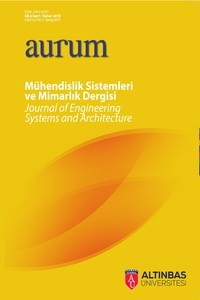Network Intrusion Detection Using Machine Learning Techniques/Makine Öğrenmesi Teknikleri Kullanılarak Ağ Saldırı Tespit Sistemi
Makine Öğrenmesi, Yapay Sinir Ağları, Saldırı Tespir Sistemi
Network Intrusion Detection Using Machine Learning Techniques/Makine Öğrenmesi Teknikleri Kullanılarak Ağ Saldırı Tespit Sistemi
___
- D. Acemoglu, A. Malekian, and A. Ozdaglar, “Network security and contagion,” Journal of Economic Theory, vol. 166, pp. 536-585, 2016.
- D. Yu, Y. Jin, Y. Zhang, and X. Zheng, “A survey on security issues in services communication of Microservices‐ enabled fog applications,” Concurrency and Computation: Practice and Experience, p. e4436.
- V. C. Storey and I.-Y. Song, “Big data technologies and Management: What conceptual modeling can do,” Data & Knowledge Engineering, vol. 108, pp. 50-67, 2017.
- I. H. Witten, E. Frank, M. A. Hall, and C. J. Pal, Data Mining: Practical machine learning tools and techniques: Morgan Kaufmann, 2016.
- M. Ahmed, A. N. Mahmood, and J. Hu, “A survey of network anomaly detection techniques,” Journal of Network and Computer Applications, vol. 60, pp. 19-31, 2016.
- K. Simonyan and A. Zisserman, “Very deep convolutional networks for large-scale image recognition,” arXiv preprint arXiv:1409.1556, 2014.
- K. Cup, “Dataset,” available at the following website http://kdd. ics. uci. edu/databases/kddcup99/kddcup99. html, vol. 72, 1999.
- M. Tavallaee, E. Bagheri, W. Lu, and A. A. Ghorbani, “A detailed analysis of the KDD CUP 99 data set,” in Computational Intelligence for Security and Defense Applications, 2009. CISDA 2009. IEEE Symposium on, 2009, pp. 1-6.
- J. McHugh, “Testing intrusion detection systems: a critique of the 1998 and 1999 darpa intrusion detection system evaluations as performed by lincoln laboratory,” ACM Transactions on Information and System Security (TISSEC), vol. 3, pp. 262-294, 2000.
- M. S. Pervez and D. M. Farid, “Feature selection and intrusion classification in NSL-KDD cup 99 dataset employing SVMs,” in Software, Knowledge, Information Management and Applications (SKIMA), 2014 8th International Conference on, 2014, pp. 1-6.
- N. Moustafa and J. Slay, “UNSW-NB15: a comprehensive data set for network intrusion detection systems (UNSW-NB15 network data set),” in Military Communications and Information Systems Conference (MilCIS), 2015, 2015, pp. 1-6.
- J. Suuronen and M. Bergenwall, “System and method of providing virus protection at a gateway,” ed: Google Patents, 2016.
- Y. Liao and V. R. Vemuri, “Use of k-nearest neighbor classifier for intrusion detection1,” Computers & security, vol. 21, pp. 439-448, 2002.
- J. R. Quinlan, C4. 5: programs for machine learning: Elsevier, 2014.
- J. Zhang, M. Zulkernine, and A. Haque, “Random-forests-based network intrusion detection systems,” IEEE Transactions on Systems, Man, and Cybernetics, Part C (Applications and Reviews), vol. 38, pp. 649-659, 2008.
- J. A. Suykens and J. Vandewalle, “Least squares support vector machine classifiers,” Neural processing letters, vol. 9, pp. 293-300, 1999.
- M. Kubat, “Artificial neural networks,” in An Introduction to Machine Learning, ed: Springer, 2015, pp. 91-111. W.-C. Lin, S.-W. Ke, and C.-F. Tsai, “CANN: An intrusion detection system based on combining cluster centers and nearest neighbors,” Knowledge-based systems, vol. 78, pp. 13-21, 2015.
- N. G. Relan and D. R. Patil, “Implementation of network intrusion detection system using variant of decision tree algorithm,” in Nascent Technologies in the Engineering Field (ICNTE), 2015 International Conference on, 2015, pp. 1-5.]
- M. Al-Zewairi, S. Almajali, and A. Awajan, “Experimental Evaluation of a Multi-layer Feed-Forward Artificial Neural Network Classifier for Network Intrusion Detection System,” in 2017 International Conference on New Trends in Computing Sciences (ICTCS), 2017, pp. 167-172.
- ISSN: 2564-6397
- Yayın Aralığı: Yılda 2 Sayı
- Başlangıç: 2017
- Yayıncı: Altınbaş Üniversitesi
TÜRKIYE’YE ÖZGÜ BITKI VE GIDA ÖRNEKLERININ TEMEL BILEŞENLER ANALIZIYLE SINIFLANDIRILMASI
MATLAB, PHYTON VEYA R KULLANARAK WEB TABANLI BÜYÜK MOLEKÜLER VERI DÖNÜŞÜM ANALIZI
POLIGON MODELLEME İLE ÖYKÜ OLUŞTURMA
ÖNCÜL BILGI TABANLI KAN PAYLAŞIM SISTEMI TASARIM VE UYGULAMASI
Tayfun ÇELİK, Oğuz BAYAT, Adil Deniz DURU, Osman Nuri UÇAN
UYDU VERILERINE DAYALI OLARAK BITKI ÖRTÜSÜ ANALIZI
Nagihan ESENDAL BOZKURT, Metin ZONTUL, Zafer ASLAN
Implementation of Different Clustering Algorithms/Farklı Sınıflandırma Algoritmalarının Uygulamaları
Amna Mohamed M. ABURAS, Wamidh MAZHER, Osman Nuri UÇAN, Oğuz BAYAT
Sefer KURNAZ, Mohanad Mohammed ABDULKAREEM, Shadha Adnan YASEEN
